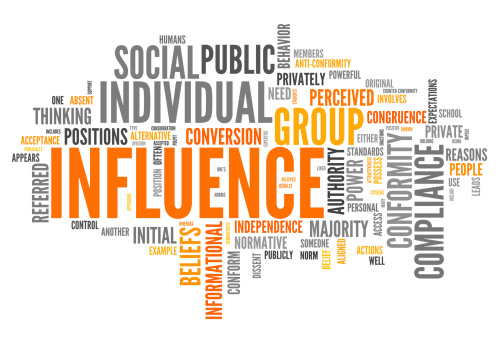
Research from SADD (Students Against Destructive Decisions) revealed that parents are the number one reason why young people make good choices. That’s the good news. The bad news is that the same research pegs peers as the number one reason why they make bad choices. Perhaps the best news of all is that peers are the number two reason young people make good choices (Wallace, 2008).
That suggests a critical tipping point of influence.
Influence, both positive and negative, is a motivating factor in behavior. In fact, social or “peer” pressure encourages others to change their attitudes, values or behaviors to conform to group norms (Brown, 2004).
Powerful stuff.
Usually the term peer pressure conjures up unsettling images of kids being coerced into drinking alcohol, using other drugs or engaging in intimate sexual behavior before they really want to. Assemblies from elementary school through high school often focus on this dark side of social norming – a process that creates the perception of normative, or normal, behavior.
And, after all, who doesn’t want to be normal?
But part of the problem is that perceptions rarely match reality. For example, the Drug Free Action Alliance (DFAA) states, “Research shows that many youth overestimate the permissive attitudes of their peers and underestimate the extent of peer support for healthy choices” (DFAA, 2015).
Too often, the damage has been already done.
That is why organizations such as SADD, Friday Night Live and DFAA encourage countermeasures, including social norming campaigns, to set the record straight. These programs are now popular on high school and college campuses and may include using social media as well as more traditional marketing methods, such as posters. One ad appearing on a college bulletin board read, “74% of Reedley College Residence Hall students do not ride with others who have been drinking. Make The Pledge!” (Friday Night Live, 2013).
At SADD, the Buzzcheck campaign is designed to encourage students to question common myths and assumptions about teen drinking, including the impact of peer pressure and the social consequences of alcohol use. Ultimately, it also seeks to arm young people with the skills they’ll need to resist underage drinking (SADD, 2010).
DFAA underscores the efficacy of such approaches, stating, “ … coalitions can help correct common misperceptions of these norms by publicizing the actual rates of alcohol, tobacco and other drug abuse within the community” (DFAA, 2015).
Beyond fixing social norm discrepancies, it is important to increase the almost nonexistent dialogue about the role that positive peer pressure can play in helping young people make sound, thoughtful decisions. Such was the driving force (pun intended) behind SADD, an organization that began at Wayland High School (MA) in 1981 in response to the deaths of two members of the varsity hockey team in impaired driving crashes just two weeks apart.
Then named Students Against Driving Drunk, SADD – with its core mission of empowering teenagers to save lives – quickly swept the across the country, changing the national narrative about impaired driving and, at one point, helping to reduce the number of young people killed in alcohol-related crashes by more than 60 percent.
Wow.
Today, echoes of that movement can be found in such important initiatives as Above the Influence, which similarly encourages youth to make positive choices and avoid potentially dangerous behaviors. The campaign, originally conceived as part of the White House Office of National Drug Control Policy, attempts to inoculate teens from pressure to conform, stating, “Knowing who you are and what you believe in is important. Recognizing the influences in your life (both good and bad) makes it easier for you to make important choices” (Above the Influence, 2015).
Young people can also help others to make good decisions. Simply setting a good example, say with regard to studying or participating in community service, and encouraging friends to do the same is a practical paradigm of positive peer pressure, or influence. So, too, is offering guidance or advice that may be better received from a peer than from a parent.
In his article “Natural Born Followers,” Mark van Vugt, Ph.D., makes the case that we are all born with a natural (survival) instinct to follow. He says, “Followership is hardwired in the brain and, lucky for us, we usually follow the right sort of people, our parents. Yet … our hardwired tendencies to follow backfire when we are exposed to the wrong sorts of models, particularly in childhood” (van Vugt, 2012).
The moral of the story? More positive peer influencers are needed. If they lead, their friends will follow.
John F. Calicchio is a sophomore at Kent School in Connecticut, where he plays varsity lacrosse and serves as class representative and peer counselor. John was the 2014 recipient of the Mount Algo Award for excellence in writing. He is also a member of the National Advisory Board at the Center for Adolescent Research and Education (CARE).
© Summit Communications Management Corporation 2015 All Rights Reserved
REFERENCES
Above the Influence. (2015). Above the crowd: be your own person. Partnership for Drug-Free Kids. National Youth Anti-Drug Media Campaign. http://abovetheinfluence.com/friends-peers/ (15 Jan. 2015).
Brown, B. B. (2004). Adolescents' relationships with peers. R. M. Lerner & L. Steinburg (Eds.), Handbook of Adolescent Psychology, 2nd ed. New York: Wiley, 2004, p 363-394. http://website.education.wisc.edu/prsg/wp-content/uploads/2014/08/Brown-2004-Adol-relations-w-peers.pdf (15 Jan. 2015).
Drug Free Action Alliance (DFAA). (2015). Impacting community norms. Ohio Center for Coalition Excellence. https://www.drugfreeactionalliance.org/occe_communitynorms (15 Jan. 2015).
Friday Night Live. (2013). Youth-led social norms campaigns. Youth Leadership Institute. July 2013. http://www.fridaynightlive.org/wp-content/uploads/YLI-FNL-social-norms_v2.pdf (15 Jan. 2015).
SADD. (2010). Buzzcheck. SADD Campaigns and Activities. Students Against Destructive Decisions. http://sadd.org/mtc.htm (15 Jan. 2015).
van Vugt, M. (2012). Natural born followers: would you betray your mother to please an evil dictator?. April 15, 2012. Naturally Selected. Psychology Today. http://www.psychologytoday.com/blog/naturally-selected/201204/natural-born-followers (15 Jan. 2015).
Wallace, Stephen. (2008). Reality Gap – Alcohol, Drugs, and Sex: What Parents Don’t Know and Teens Aren’t Telling. New York: Union Square Press/Sterling Publishing Company. 2008.



























